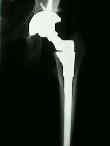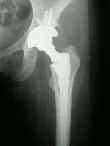- See:
- PreOperative Planning:
- preoperative leg length:
- acetabulum:
- evaluation of cup position:
- acetablar component loosening
- use a wax pen to mark the tear drop and the superior aspect of the acetabulum, and overlie the acetabular templates to determine
the proper sizes;
- cup selection:
- deep profile cups (often used for revisions);
- SP+6 are required for greater lateral offset;
- center of rotation:
- will determine the center of rotation of the femoral head;
- femoral component:
- draw the "lateral endosteal line" to help determine the starting point for straight entry down the medullary canal;
- this line will help determine need for trochanteric osteotomy;
- when a cemented femoral component has been placed in significant varus, then consider the need for an extended trochanteric
osteotomy in order have adequate access to the lateral cortex (and avoid perforation);
- restoration of neck length (and calcar):
- neck lengths come in 36 and 42 mm;
- trochanteric osteotomy
- if osteotomy is required, determine where the lateral osteotomy cut will lie in relation to the proximal sleeve;
- Stem Diameters:
- proximal stem diameter is always 5 mm wider than the distal diameter;
- available from (9/14) to (19/24);
- reamers:
- straight reamers are inserted (beginning at 8 mm) and are sequentially reamed until cortical contact is achieved;
- reamers must be of same size or 0.5 mm larger than minor diameter size;
- flexible reamers are used for curved femoral stems and are over-sized by 1-2 mm;
- Stem Lengths:
- strainght stems:
- available as standard, long, X-long, and XX-long;
- stems are interchangable for both left and right femurs;
- allow variable anteversion;
- curved stems: (anterior bow);
- available in long, X-long, and XX-long;
- must have specific right or left stem;
- version is pre-determined;
- Femoral Necks:
- all neck are set at 135 deg;
- standard necks: 30, 36 and 42 mm;
- standard neck w/ lateral offset: 30 mm + 4 mm, 36 mm + 4 mm, and 42 mm + 8 mm;
- calcar replacements: (21 mm)
- CR: 36 mm
- CR + 4 mm;
- CR + 8 mm;
- Proximal Sleeve:
- inner diameter refers to the proximal stem diameter;
- outer diameter (cone size):
- B: adds 3 mm to stem diameter;
- D: adds 5 mm to stem diameter;
- F: adds 7 mm to stem diamet;
- F-oversize: adds 9 mm;
- conical reamers:
- conical reamers are inserted down to the marking for the neck length desired (30, 36, 42 mm) as referenced off the top of the greater
trochanter;
- hand reaming is continued until cortical contact is achieved;
- if the top of the conical reamer is below the lesser trochanter, then use the calcar replacement neck (36 / 21 mm);
- note that counter-clockwise reaming will disassemble the reamer;
- conical reamer sizes:
- 14 mm / B reamer (14 + 3 = 17 mm diameter)
- 14 mm / D reamer (14 + 5 = 19 mm diameter)
- 14 mm / F reamer (14 + 7 = 21 mm diameter)
- 16 mm / B reamer (16 + 3 = 19 mm diameter)
- 16 mm / D reamer (16 + 5 = 21 mm diameter)
- 16 mm / F reamer (16 + 7 = 23 mm diameter)
- 18 mm / B reamer (18 + 3 = 21 mm diameter)
- 18 mm / D reamer (18 + 5 = 23 mm diameter)
- 18 mm / F reamer (18 + 7 = 25 mm diameter)
- 20 mm / B 23 mm
- 20 mm / D 25 mm
- 20 mm / F 27 mm
- 22 mm / B 25 mm
- 22 mm / D 27 mm
- 22 mm / F 29 mm
- 24 mm / B 27 mm
- 24 mm / D 29 mm
- 24 mm / F 31 mm
- Femoral Head / Lateral Offset:
- available in +0, +6, +12 mm;
- Calcar Miller:
- determine the most optimal direction for the calcar miller (usually miller);
- miller jig sizes range from 2 to 9 and are based upon the conical reamer size;
- insert the miller frame down the canal to the level of the desired femoral neck cut, as referenced off the tip of the greater trochanter;
- position the miller ring over the region with the best bone (usual medial);
- miller cutter diameter is the same size as the original proximal stem size (14 to 24 mm);
- partially withdraw the miller frame, insert the miller cutter down to the pilot hole;
- lower the miller frame and begin cutting unitl cortical bone is reached;
- the appropriate triangle size is read from markings at the top of the sleeve;
- triangle size: (medial extension of the triangle)
- small: adds 9.5 mm from the cone outer diameter;
- large: adds 13.5 mm from the cone OD;
- XX-large: adds 17.5 mm from the cone OD;
- Considerations for Trial Stem Insertion:
- straight stems:
- appropriately sized trial sleeve is pressed into place;
- appropriately sized sleeve introducer (14 to 24 mm) is attached to sleeve introducer handle;
- subsequently screw on the distal pilot shaft (5 mm less than sleeve introducer);
- the smooth portion of the introducer should face the greater trochanter, so that the slots in the sleeve fit into the stem;
- once stem is seated, the version can be set (each click is 10 deg);
- this version can be marked on the femoral neck using cautery;
- bowed stems: the trial sleeve and stem are inserted at the same time;
- version is pre-determined with bowed stems;
- Considerations for Prosthetic Stem Insertion:
- straight stems:
- seat the proximal sleeve:
- appropriately sized prosthetic sleeve is pressed into place;
- appropriately sized sleeve introducer (14 to 24 mm) is attached to sleeve introducer handle;
- screw on the distal pilot shaft (5 mm less than sleeve introducer);
- insert the assembly into the sleeve (smooth portion facing greater trochanter) and tap the assembly until the sleeve is fully seated;
- straight stem insertion:
- the appropriately sized stem (and neck length) are carefully inserted through the proximal sleeve w/ care to maintain the same
version that was achieved w/ the trial reduction;
- the "medial midline" of the prosthesis is aligned with the previously made mark on the femoral stem;
- use the stem driver to impact the stem down into the proximal sleeve;
- bowed stems: the trial sleeve and stem are inserted at the same time;
- version is pre-determined with bowed stems



